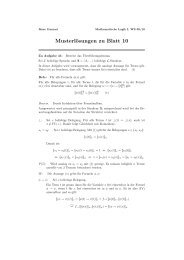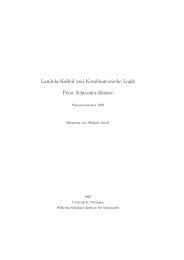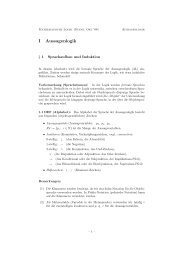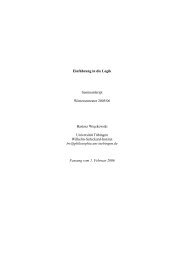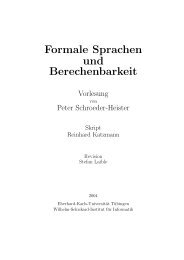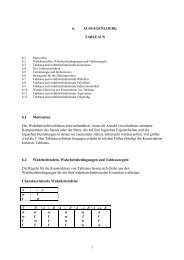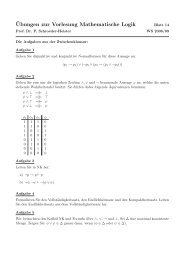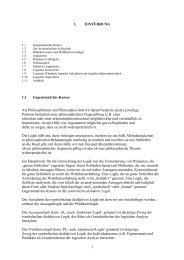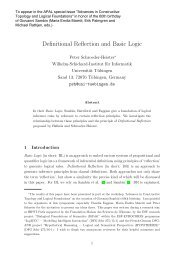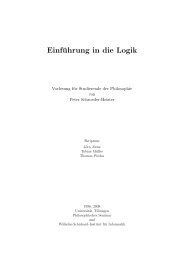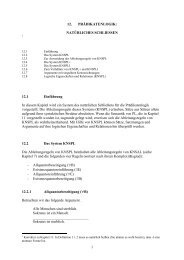Constructive semantics and the validity of Peirce's law
Constructive semantics and the validity of Peirce's law
Constructive semantics and the validity of Peirce's law
Create successful ePaper yourself
Turn your PDF publications into a flip-book with our unique Google optimized e-Paper software.
In o<strong>the</strong>r words, Γ � q holds if <strong>and</strong> only if <strong>the</strong> basic rule p1 . . . pn<br />
q<br />
is admissible in<br />
all bases B. That is, for atoms <strong>and</strong> <strong>the</strong> empty basis <strong>the</strong> notion <strong>of</strong> valid inferability is<br />
equivalent to <strong>the</strong> notion <strong>of</strong> admissibility in all bases. Therefore, for <strong>the</strong> empty basis<br />
<strong>and</strong> for atoms p <strong>and</strong> q, we have<br />
� p ⊃ q ⇐⇒ For all bases B: If ⊢B p, <strong>the</strong>n ⊢B q<br />
In o<strong>the</strong>r words, p ⊃ q is valid if <strong>and</strong> only if <strong>the</strong> basic rule p<br />
q<br />
is admissible in every<br />
basis. But can admissibility be taken as a sufficient condition for <strong>validity</strong> <strong>of</strong> o<strong>the</strong>r<br />
sentences more complex than implications p ⊃ q ?<br />
The answer is positive, at least for a special case <strong>of</strong> Peirce’s rule considered below.<br />
We first show a completeness <strong>the</strong>orem for <strong>the</strong> derivability <strong>of</strong> atoms from assumptions<br />
which are ei<strong>the</strong>r atoms or implications between atoms.<br />
Theorem 3 (Atomic completeness) Suppose ϕ1, . . . , ϕn �B p, where each ϕi (1 ≤ i ≤<br />
n) is ei<strong>the</strong>r an atom pi or an implication pi ⊃ qi between atoms. Then ϕ1, . . . , ϕn ⊢B p.<br />
Pro<strong>of</strong>. We know that p is derivable in every extension C <strong>of</strong> B, for which �C ϕi holds<br />
for every i (1 ≤ i ≤ n). Now consider <strong>the</strong> extension C ′ <strong>of</strong> B, which is obtained from<br />
B in <strong>the</strong> following way: For every i we add pi as an axiom, if ϕi is an atom pi, <strong>and</strong><br />
we add<br />
pi<br />
qi<br />
as a basic rule, if ϕi is an implication pi ⊃ qi. Then �C ′ ϕi for every i (1 ≤ i ≤ n).<br />
Therefore p is derivable in C ′ . If we now replace every application <strong>of</strong> a rule<br />
by an application <strong>of</strong> (⊃E)<br />
pi<br />
qi<br />
pi pi ⊃ qi<br />
qi<br />
we obtain a derivation <strong>of</strong> p from ϕ1, . . . , ϕn over B. �<br />
This (restricted) completeness <strong>the</strong>orem is an immediate consequence <strong>of</strong> <strong>the</strong> fact<br />
that in <strong>the</strong> semantical clause (2) <strong>of</strong> consequence <strong>and</strong> thus <strong>of</strong> implication (clause (3))<br />
arbitrary extensions <strong>of</strong> bases are considered.<br />
3.2 Admissibility <strong>of</strong> Peirce’s rule<br />
Instead <strong>of</strong> reconsidering <strong>the</strong> rule <strong>of</strong> double negation elimination, we concentrate on<br />
Peirce’s rule <strong>and</strong> on Peirce’s <strong>law</strong>. This has <strong>the</strong> advantage that only <strong>the</strong> clauses (1), (2)<br />
<strong>and</strong> (3) <strong>of</strong> S<strong>and</strong>qvist’s Definition 1 are relevant, whereas <strong>the</strong> justification <strong>of</strong> double<br />
negation elimination depends on clause (4) for ⊥ in addition. Thus any possible<br />
reservations one might have about clause (4) do not interfere with <strong>the</strong> following<br />
discussion. As a justification <strong>of</strong> Peirce’s rule amounts to a justification <strong>of</strong> classical<br />
logic just as a justification <strong>of</strong> double negation elimination does, using Peirce’s rule to<br />
this effect is not an undue choice. Indeed, as S<strong>and</strong>qvist points out (ibid., p. 215):<br />
6



